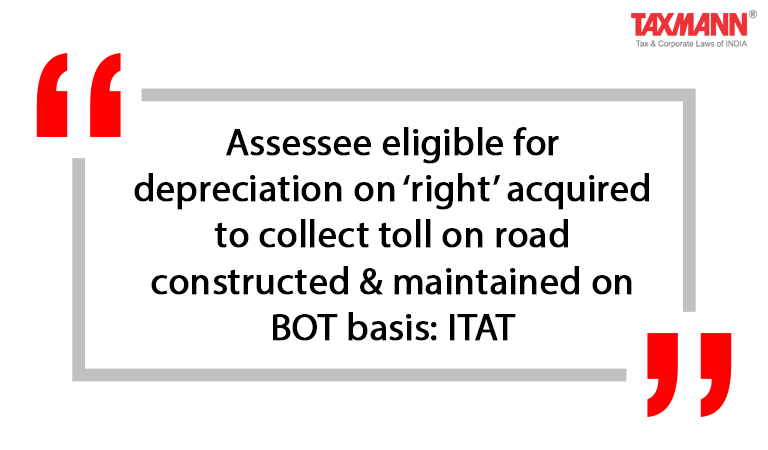Assessee eligible for depreciation on ‘right’ acquired to collect toll on road constructed & maintained on BOT basis: ITAT
- Blog|News|Income Tax|
- 3 Min Read
- By Taxmann
- |
- Last Updated on 29 November, 2022
Case Details: DCIT v. Ashoka Dhankuni Kharagpur Tollway Ltd. - [2022] 145 taxmann.com 97 (Pune -Trib.)
Judiciary and Counsel Details
-
- Inturi Rama Rao, Accountant Member & S.S. Viswanethra Ravi, Judicial Member
- Deepak Garg for the Appellant.
- Pramod Shingte for the Respondent.
Facts of the Case
Assessee was a company incorporated to undertake infrastructure projects. It was engaged in the construction and maintenance of roads under the Build, Operate and Transfer (BOT) scheme of the Government. Under this scheme, the assessee was required to arrange the funds required to construct and maintain the road facility on its own. The assessee was given license to collect tolls on the road facility.
During the relevant assessment year, the assessee filed return claiming a depreciation license to collect toll treating it as intangible assets. However, Assessing Officer (AO) contended that the road facility developed was not owned by it. Therefore, the road facility developed wasn’t an asset for the assessee and disallowed the claim of depreciation.
On appeal, the CIT(A) allowed the assessee’s appeal. Aggrieved-assessee filed the instant appeal before the Pune Tribunal.
ITAT Held
The Tribunal held that as a result of developing the project, the assessee acquired the commercial right to collect the toll in terms of the arrangement as per the terms of NHAI.
The assessee had incurred huge costs on the construction of the road facility, which in commercial reality, was for acquiring the right to collect tolls. Also, it had capitalized all the costs incurred for construction as the cost incurred for the acquisition of the license to collect tolls.
Thus, the real asset for the assessee was the right to collect toll and not the road facility constructed. Therefore, the condition of ownership was fulfilled as envisaged under section 32 for the license to collect tolls.
Accordingly, the right falls under the meaning of commercial right or intangible asset. Accordingly, it would qualify for depreciation under section 32 at the rate of 25%.
List of Cases Reviewed
-
- North Karnataka Expressway Ltd. v. CIT [2014] 51 taxmann.com 214/[2015] 228 Taxman 20 (Mag.)/372 ITR 145 (Bom.)
- CIT v. West Gujarat Expressway Ltd. [2017] 82 taxmann.com 224/390 ITR 398 (Bom.)
- CIT v. West Gujarat Expressway Ltd. [2016] 73 taxmann.com 139/242 Taxman 127/[2017] 390 ITR 400 (Bom.) (para 9) distinguished.
List of Cases Referred to
-
- Asstt. CIT v. Jaora Nayagaon Toll Road Company (P.) Ltd. [IT Appeal Nos. 379 & 380 (Pun.) of 2016, dated 29-11-2017] (para 6)
- ACIT v. Joara Nayagaon Toll Road Company (P.) Ltd. [IT Appeal Nos. 1525 to 1527 (Pun.) of 2018, dated 11-1-2022] (para 6)
- Dy. CIT v. Ashoka Highways Bhandara Ltd. [IT Appeal Nos. 1388 & 1389 (Pun.) of 2018, dated 1-11-2021] (para 6)
- Ashoka Infrastructure Ltd. v. Asstt. CIT [IT Appeal Nos. 1452 to 1457 (Pun.) of 2014, dated 30-6-2017] (para 6)
- Asstt. CIT v. Progressive Constructions Ltd. [2018] 92 taxmann.com 104 (Hyd. – Trib.) (SB) (para 6)
- CIT v. Tamil Nadu Road Development Co. Ltd. [2021] 130 taxmann.com 63/283 Taxman 168 (Mad.) (para 6)
- CIT v. GVK Jaipur Kishangarh Expresway Ltd. [D.B. IT Appeal No. 232 of 2016, dated 10-10-2017] (para 8)
- Moradabad Toll Road Co. Ltd. v. Asstt CIT [2014] 52 taxmann.com 21/[2015] 228 Taxman 17 (Mag.)/[2014] 369 ITR 403 (Delhi) (para 8)
- CIT v. Noida Toll Bridge Co. Ltd. [2013] 30 taxmann.com 207/213 Taxman 333 (All.) (para 8)
- CIT v. VGP Housing (P.) Ltd. [2016] 66 taxmann.com 354/[2014] 368 ITR 565 (Mad.) (para 8)
- CIT v. Jawahar Kala Kendra [2014] 43 taxmann.com 159/222 Taxman 222/362 ITR 515 (Raj.) (para 8)
- CIT v. Mohd. Bux Shokat Ali [2001] 118 Taxman 712/[2002] 256 ITR 357 (Raj.) (para 8)
- North Karnataka Expressway Ltd. v. CIT [2014] 51 taxmann.com 214/[2015] 228 Taxman 20 (Mag.)/372 ITR 145 (Bom.) (para 9)
- CIT v. West Gujarat Expressway Ltd. [2017] 82 taxmann.com 224/390 ITR 398 (Bom.) (para 9)
- CIT v. West Gujarat Expressway Ltd. [2016] 73 taxmann.com 139/242 Taxman 127/[2017] 390 ITR 400 (Bom.) (para 9).
Disclaimer: The content/information published on the website is only for general information of the user and shall not be construed as legal advice. While the Taxmann has exercised reasonable efforts to ensure the veracity of information/content published, Taxmann shall be under no liability in any manner whatsoever for incorrect information, if any.

Taxmann Publications has a dedicated in-house Research & Editorial Team. This team consists of a team of Chartered Accountants, Company Secretaries, and Lawyers. This team works under the guidance and supervision of editor-in-chief Mr Rakesh Bhargava.
The Research and Editorial Team is responsible for developing reliable and accurate content for the readers. The team follows the six-sigma approach to achieve the benchmark of zero error in its publications and research platforms. The team ensures that the following publication guidelines are thoroughly followed while developing the content:
- The statutory material is obtained only from the authorized and reliable sources
- All the latest developments in the judicial and legislative fields are covered
- Prepare the analytical write-ups on current, controversial, and important issues to help the readers to understand the concept and its implications
- Every content published by Taxmann is complete, accurate and lucid
- All evidence-based statements are supported with proper reference to Section, Circular No., Notification No. or citations
- The golden rules of grammar, style and consistency are thoroughly followed
- Font and size that’s easy to read and remain consistent across all imprint and digital publications are applied








 CA | CS | CMA
CA | CS | CMA


